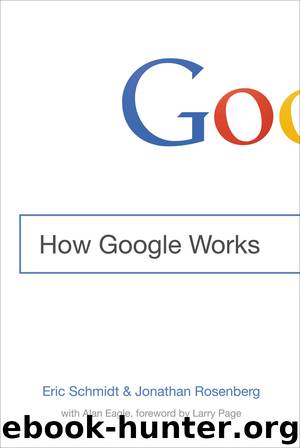How Google Works by Eric Schmidt & Alan Eagle

Author:Eric Schmidt & Alan Eagle
Language: eng
Format: epub, mobi
Tags: Business & Economics / Leadership
Publisher: Grand Central Publishing
Published: 2014-09-22T16:00:00+00:00
Know when to ring the bell
This conflict-based approach works only if it is managed by a single decision-maker who owns the deadline and will break a tie. Often there is too much data, or the data is inconclusive. When that happens, people can debate for hours, a time sink that often ends in mediocre compromise and always incurs a hefty opportunity cost, since there are always better things for smart creatives to be doing than rehashing a decision for the umpteenth time. There is a point at which more analysis won’t lead to a better decision. This is the most important duty of the decision-maker: Set a deadline, run the process, and then enforce the deadline. It’s like the kids on the playground at recess; they will play forever, but when the bell rings they know they have to wrap it up and head back to class. (Hopefully employees are better behaved and less prone to hogging the monkey bars.) The decision-maker gets to decide how long recess lasts, then ring the bell.129
Our coach and mentor Bill Campbell told us a story of how he had just joined Intuit as its CEO when he heard of an important product decision that had stalled. The executive in charge of the product had gathered plenty of data, but the numbers were inconclusive. So he ordered up more research. Then, when the new set of data was still not helpful, he ponied up for yet another feeding at the data trough. Bill got wind of this and ordered a stop to the dillydallying. “Do something,” he told the executive, “even if it’s wrong.”
Tom Peters would call Bill’s attitude in this situation a “bias for action,” and his book In Search of Excellence lists it as a top common attribute of the companies he studied.130 Many designers also believe a bias for action is a positive force, nothing short of “a core… mindset of design thinking,” according to the Stanford design school (aka the d.school, because “design school” isn’t designy enough).131 It promotes a hands-on, trial-and-error approach: If you’re not sure if a course of action is right, the best thing you can do is try it out and then correct course.132
But some behavioral economists believe that a bias for action can be deleterious, since it can favor hasty, poorly thought-out decisions, and in some situations we agree. In a negotiation, for example, Eric’s “PIA” rule can help get the best outcome: Have patience, information, and alternatives. P is especially important. You want to wait as long as possible before committing to a course of action. This is true in fields beyond business too (or should we say “pitches”): Soccer goalies who are facing penalty kicks can double their save rate by simply doing nothing at the moment the shooter kicks the ball, rather than following the common bias-for-action practice of guessing in advance to which side the kick will go and diving in that direction.133 In that way, goalies could learn from pilots,
Download
How Google Works by Eric Schmidt & Alan Eagle.mobi
This site does not store any files on its server. We only index and link to content provided by other sites. Please contact the content providers to delete copyright contents if any and email us, we'll remove relevant links or contents immediately.
Hit Refresh by Satya Nadella(9071)
When Breath Becomes Air by Paul Kalanithi(8362)
The Girl Without a Voice by Casey Watson(7841)
A Court of Wings and Ruin by Sarah J. Maas(7721)
Do No Harm Stories of Life, Death and Brain Surgery by Henry Marsh(6903)
Shoe Dog by Phil Knight(5214)
The Rules Do Not Apply by Ariel Levy(4904)
A Higher Loyalty: Truth, Lies, and Leadership by James Comey(4901)
Hunger by Roxane Gay(4891)
Tuesdays with Morrie by Mitch Albom(4723)
Everything Happens for a Reason by Kate Bowler(4698)
The Immortal Life of Henrietta Lacks by Rebecca Skloot(4546)
Millionaire: The Philanderer, Gambler, and Duelist Who Invented Modern Finance by Janet Gleeson(4414)
How to Change Your Mind by Michael Pollan(4311)
All Creatures Great and Small by James Herriot(4266)
The Money Culture by Michael Lewis(4122)
Man and His Symbols by Carl Gustav Jung(4091)
Elon Musk by Ashlee Vance(4080)
Tokyo Vice: An American Reporter on the Police Beat in Japan by Jake Adelstein(3950)
